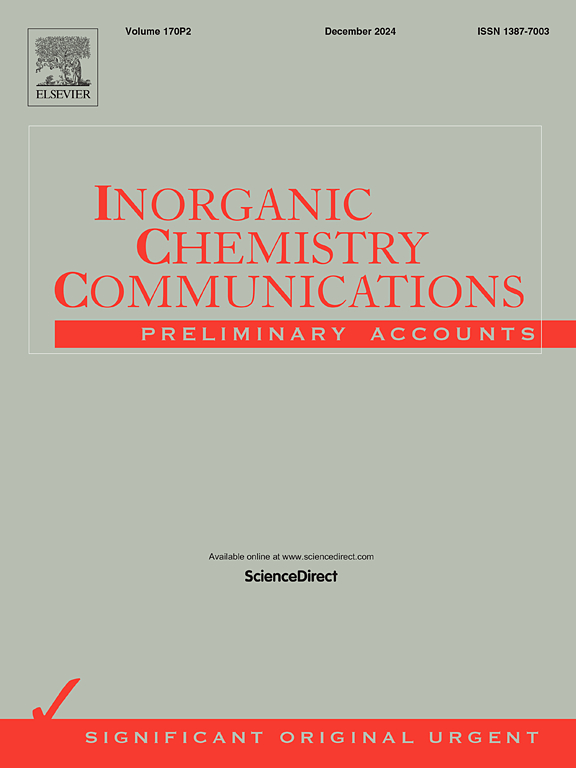Highly water soluble metallophthalocyanines and investigation of their AChE/BuChE enzyme inhibition and cytotoxic activity against human neuroblastoma (SH-SY5Y) cell
IF 4.4
3区 化学
Q1 CHEMISTRY, INORGANIC & NUCLEAR
引用次数: 0
Abstract
The new morpholine substituted Mn(III), Co(II), Cu(II) and Zn(II) phthalocyanines compounds were synthesized for the first time by cyclotetramerization reaction. In addition, their water-soluble derivatives were obtained using a simple method, stirring CH3I in chloroform at room temperature in the dark. The water-soluble compounds are highly soluble in water at room temperature. The inhibitory activities of these compounds against the cholinergic enzyme AChE/BuChE were investigated using a spectrophotometric method. When compared to the positive control galantamine, all of the water-soluble phthalocyanine compounds demonstrated strong inhibition of AChE/BuChE with values of 4.51 µM and 7.37 µM, respectively. MT-C3-ZnQ had the highest inhibition activity of the compounds tested. Kinetic studies were performed in a systematic manner to determine the type of inhibition and the inhibitor’s binding constant to the enzyme. As a result, it was discovered that compound MT-C3-ZnQ inhibited AChE/BuChEs of mixed type. Furthermore, the cell viability of the MT-C3-ZnQ compound on the human neuroblastoma (SH-SY5Y) cell line was assessed at 24 and 48 h using the MTT assay. The MTT assay revealed that SH-SY5Y cells exposed to MT-C3-ZnQ for 24 h exhibited no cytotoxicity, with no apparent dose–response relationship. Similarly, no cytotoxicity was observed after 48 h of exposure and cell viability above 70 % was observed, compared to the control group. All of these findings suggest that the MT-C3-ZnQ compound, with its low cytotoxicity and high enzyme inhibition activity against AChE/BuChE enzymes, could be a viable alternative to drugs used in the treatment of Alzheimer’s. Furthermore, this study is expected to serve as a model for future research in this area.

高水溶性金属酞菁及其对人神经母细胞瘤(SH-SY5Y)细胞AChE/BuChE酶抑制和细胞毒活性的研究
采用环四聚反应首次合成了新的取代Mn(III)、Co(II)、Cu(II)和Zn(II)的酞菁化合物。此外,用一种简单的方法,在室温下,在黑暗中,在氯仿中搅拌CH3I,得到了它们的水溶性衍生物。水溶性化合物在室温下极易溶于水。用分光光度法研究了这些化合物对胆碱能酶AChE/BuChE的抑制活性。与阳性对照加兰他明相比,所有水溶性酞菁化合物对AChE/BuChE的抑制作用分别为4.51µM和7.37µM。MT-C3-ZnQ的抑制活性最高。动力学研究以系统的方式进行,以确定抑制类型和抑制剂与酶的结合常数。结果发现,化合物MT-C3-ZnQ对混合型AChE/BuChEs有抑制作用。此外,采用MTT法评估MT-C3-ZnQ化合物对人神经母细胞瘤(SH-SY5Y)细胞株在24和48 h时的细胞活力。MTT实验显示,SH-SY5Y细胞暴露于MT-C3-ZnQ 24 h后无细胞毒性,且无明显的剂量-反应关系。同样,与对照组相比,暴露48 h后未观察到细胞毒性,细胞存活率高于70%。所有这些发现表明,MT-C3-ZnQ化合物具有低细胞毒性和对AChE/BuChE酶的高酶抑制活性,可能成为治疗阿尔茨海默病的可行替代药物。此外,本研究可望为未来该领域的研究提供一个范本。
本文章由计算机程序翻译,如有差异,请以英文原文为准。
求助全文
约1分钟内获得全文
求助全文
来源期刊

Inorganic Chemistry Communications
化学-无机化学与核化学
CiteScore
5.50
自引率
7.90%
发文量
1013
审稿时长
53 days
期刊介绍:
Launched in January 1998, Inorganic Chemistry Communications is an international journal dedicated to the rapid publication of short communications in the major areas of inorganic, organometallic and supramolecular chemistry. Topics include synthetic and reaction chemistry, kinetics and mechanisms of reactions, bioinorganic chemistry, photochemistry and the use of metal and organometallic compounds in stoichiometric and catalytic synthesis or organic compounds.
 求助内容:
求助内容: 应助结果提醒方式:
应助结果提醒方式:


